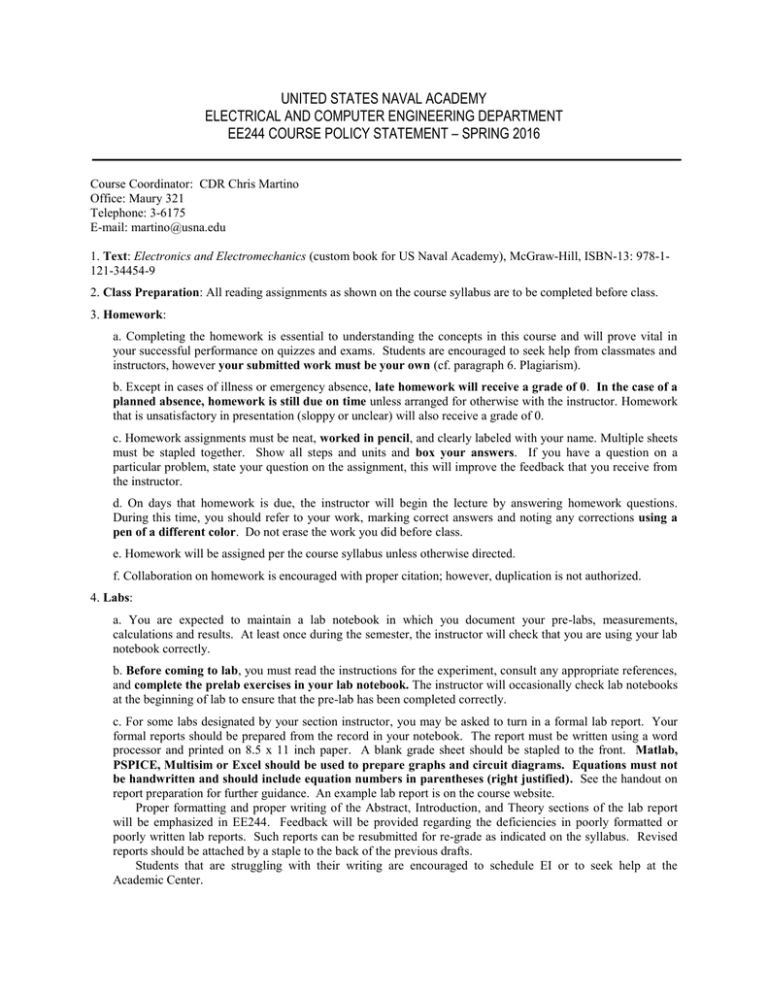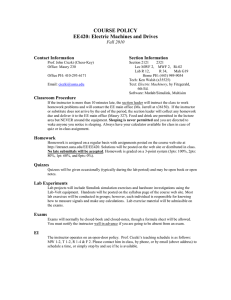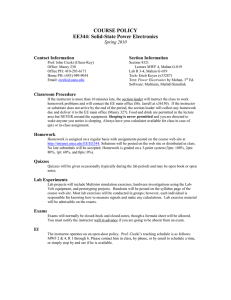UNITED STATES NAVAL ACADEMY ELECTRICAL AND COMPUTER ENGINEERING DEPARTMENT
advertisement

UNITED STATES NAVAL ACADEMY ELECTRICAL AND COMPUTER ENGINEERING DEPARTMENT EE244 COURSE POLICY STATEMENT – SPRING 2016 Course Coordinator: CDR Chris Martino Office: Maury 321 Telephone: 3-6175 E-mail: martino@usna.edu 1. Text: Electronics and Electromechanics (custom book for US Naval Academy), McGraw-Hill, ISBN-13: 978-1121-34454-9 2. Class Preparation: All reading assignments as shown on the course syllabus are to be completed before class. 3. Homework: a. Completing the homework is essential to understanding the concepts in this course and will prove vital in your successful performance on quizzes and exams. Students are encouraged to seek help from classmates and instructors, however your submitted work must be your own (cf. paragraph 6. Plagiarism). b. Except in cases of illness or emergency absence, late homework will receive a grade of 0. In the case of a planned absence, homework is still due on time unless arranged for otherwise with the instructor. Homework that is unsatisfactory in presentation (sloppy or unclear) will also receive a grade of 0. c. Homework assignments must be neat, worked in pencil, and clearly labeled with your name. Multiple sheets must be stapled together. Show all steps and units and box your answers. If you have a question on a particular problem, state your question on the assignment, this will improve the feedback that you receive from the instructor. d. On days that homework is due, the instructor will begin the lecture by answering homework questions. During this time, you should refer to your work, marking correct answers and noting any corrections using a pen of a different color. Do not erase the work you did before class. e. Homework will be assigned per the course syllabus unless otherwise directed. f. Collaboration on homework is encouraged with proper citation; however, duplication is not authorized. 4. Labs: a. You are expected to maintain a lab notebook in which you document your pre-labs, measurements, calculations and results. At least once during the semester, the instructor will check that you are using your lab notebook correctly. b. Before coming to lab, you must read the instructions for the experiment, consult any appropriate references, and complete the prelab exercises in your lab notebook. The instructor will occasionally check lab notebooks at the beginning of lab to ensure that the pre-lab has been completed correctly. c. For some labs designated by your section instructor, you may be asked to turn in a formal lab report. Your formal reports should be prepared from the record in your notebook. The report must be written using a word processor and printed on 8.5 x 11 inch paper. A blank grade sheet should be stapled to the front. Matlab, PSPICE, Multisim or Excel should be used to prepare graphs and circuit diagrams. Equations must not be handwritten and should include equation numbers in parentheses (right justified). See the handout on report preparation for further guidance. An example lab report is on the course website. Proper formatting and proper writing of the Abstract, Introduction, and Theory sections of the lab report will be emphasized in EE244. Feedback will be provided regarding the deficiencies in poorly formatted or poorly written lab reports. Such reports can be resubmitted for re-grade as indicated on the syllabus. Revised reports should be attached by a staple to the back of the previous drafts. Students that are struggling with their writing are encouraged to schedule EI or to seek help at the Academic Center. d. If you are absent from your regular laboratory session you are still responsible for completing the work and submitting the laboratory report at the same time it would normally be due, unless your absence is due to illness or an emergency. The laboratory is generally available from 0800 to 1600, except when in use by scheduled classes. ALWAYS KEEP THE DOOR OPEN WHILE YOU ARE IN THE LABORATORY AND FOLLOW THE SAFETY RULES. e. One lab exam will be administered during the semester where you will be asked to individually demonstrate key laboratory skills. This exam will contribute significantly to your course grade. f. The design project for the course requires you to design, build, and demonstrate an electronic circuit on a printed circuit board small enough to fit within an Altoids tin. Traditionally, this has been a fun project; more details will be provided later in the semester. 5. Plagiarism: Do not turn in someone else’s work as your own; this is an honor violation. Give credit where credit is due. You may collaborate with your classmates on homework, and you can get help from them on projects as needed. If a classmate is particularly helpful to you, credit should be indicated on the assignment. You are strongly discouraged from relying on solutions for homework or projects available from the Internet, or solutions obtained from previous students (note: it is not particularly difficult for an instructor to recognize this), but if used credit should be clearly indicated by citing the website or the students from whom you received the solution (even if referenced only to check your solution). Otherwise it is an honor violation. Exams must be done by you ONLY with no assistance from anyone else. 7. Examinations and Quizzes: Two midterms exams and one final exam will be given. Quizzes will be given at the discretion of the instructor. 8. Calculators: According to Division and Department policies (see http://intranet.usna.edu/EE/notices.php), when using a calculator on quizzes and exams, you must use a calculator approved for use on the Fundamentals of Engineering Exam (FE). FE-approved calculators are listed at: http://ncees.org/exams/calculator-policy/. We recommend you choose a calculator that supports the use of complex numbers. The price for some of these calculators is as low as $15. Exchanging calculators with another student during an exam or quiz is prohibited. 9. Absence/Makeup Policy: You must notify your instructor prior to missing class if you will be absent. Arranging for make-ups of exams or quizzes is your responsibility. The make up must be completed within one week of the absence. 10. Extra Instruction: Please seek EI as often as you feel you need it. Make an appointment beforehand and come prepared with specific questions and any material you wish to discuss. 11. E-mail, shared drive, and the web: The course will rely heavily on e-mail, the shared drive, and the web for communication. Check your e-mail at least once daily. In general, course policies and the syllabus, with reading and homework assignments, labs, and supplementary material will be posted on the course website found at http://www.usna.edu/EE/ec244/. 12. Late/Missing Instructor: Section leaders must report instructor no-shows to the ECE Department office (x6150). The class is not automatically excused. If no assignment has been left, students should work on homework and read ahead in the textbook. The section leader will collect homework due for that lesson period and submit it to the ECE Department. 13. Grading Policy: Midterm Exams (2)………………………………………... 40% (20% each) Lab Practicum ……………………………………………… 5% Final Exam…………………………………………………. 25% Homework, Quizzes, Labs………………………………… 25% Design Project ………………………………………………… 5% The instructor reserves the right to adjust your final grade based on his evaluation of your overall course performance including preparation, effort and participation. 14. Course Objectives: Understand the basic structure and operation of diodes, bipolar junction and field-effect transistors, operational amplifiers, and comparators. Solve for voltages and currents in simple semiconductor device circuits. Apply and implement large-signal device models, and understand their use in switching and digital circuits. Design basic logic gates using transistors Apply programming skills to model circuits using circuit modeling tools. Design, simulate, build, prototype, test, debug, and troubleshoot basic electronics circuits in a laboratory environment. Understand AC power in single-phase and three-phase circuits and have the ability to make basic power calculations. Prototype circuits in the lab, use measurement equipment to collect data, and then use the data to make basic calculations regarding circuit performance. Properly record and report laboratory work




